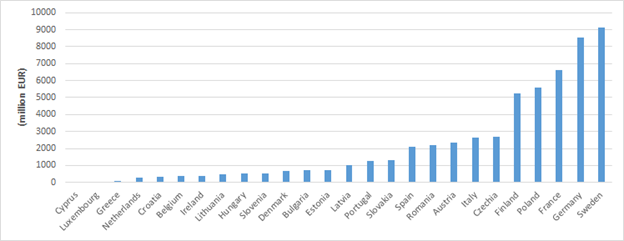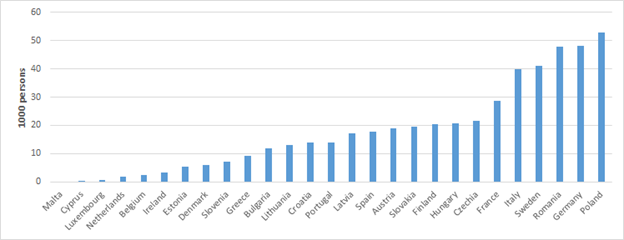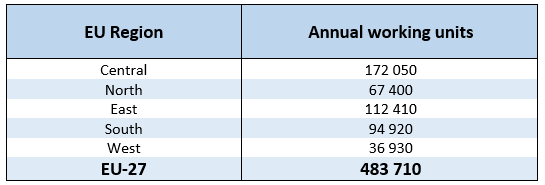Read the summaries
- EN: How does forest management and the use of wood contribute to economic prosperity and employment?
- DE: Wie tragen die Waldbewirtschaftung und die Verwendung von Holz zu wirtschaftlichem Wohlstand und Arbeitsplatzbeschaffung bei?
- ES:¿Cómo contribuyen la gestión forestal y el uso de la madera a la prosperidad económica y al empleo?
- FR: Comment la gestion forestière et l’utilisation du bois contribuent-elles à la prospérité économique et à l’emploi ?
- IT: In che modo la gestione forestale e l'impiego del legno contribuiscono alla prosperità economica e all'occupazione?
Authors: Marko Lovrić, Pekka Leskinen, Diana Tuomasjukka (EFI)
Forests cover 40% of the EU 27 territory, 159 million hectares in total (Forest Europe, 2020). Most of the forests are actively managed for timber production, with about 500 million cubic meters of roundwood harvested in 2019 (Eurostat 2020a). Timber production is an important pillar of the forest-based bioeconomy and source of income from forest operations from traditional and emerging wood-based products and related sectors and value chains. However, it is not the only goal of forest management. Forest serve as protective forests (e.g. for avalanche or erosion protection), for health, tourism and recreation functions and sectors in shared land use such as agroforestry regimes, and forest management reflects these different needs and supports employment in various ways.
According to Eurostat (2020a), total economic output from forestry and logging was 55 796 million Euros (EU-27; year 2017) with the highest outputs from Sweden, Germany and France (Fig. 1) and differences between the EU regions (Table 1).
Figure 1. Total economic output of forestry in logging at basic prices by country (EU-27, 2017)
Table 1: Total economic output from forestry and logging by regions (EU-27, 2017).
The EU’s wood-based industries cover a range of downstream activities (Eurostat, 2020a), including woodworking industries, large parts of the furniture industry, pulp and paper manufacturing and converting industries, and the printing industry. Together, some 401 000 enterprises were active in wood-based industries across the EU-27 in 2018; they represented 20.0 % of manufacturing enterprises across the EU-27, highlighting that - with the exception of pulp and paper manufacturing that is characterised by economies of scale - many wood-based industries had a relatively high number of small or medium-sized enterprises.
The economic importance of an industry can be measured by the share of its Gross Value Added (GVA) in the economy. In 2017, the GVA of wood-based industries in the EU-27 was EUR 129 billion Euros or 7.1% of the total manufacturing industry. Within the EU-27’s wood-based industries, the largest GVA was recorded for pulp, paper and paper products manufacturing (34% or 44 billion Euros). With regard to the other three sectors, printing and service activities related to printing amounted to 19% of the GVA of wood-based industries, while the manufacture of furniture and manufacturing of wood and wood products each made up between 23% and 24%.
The forestry sector in the EU-27 (in 2017) employed 483,700 persons, with the highest values reported for Poland (52,700), Germany (48,000) and Sweden (41,000) (Fig. 2), and with big regional differences (Table 2). On average, labour productivity in European forestry is 40,000 and 50,000 Euros of value added per person (Ronzon and M’Barek, 2018).
Figure 2. Employment in forestry and logging by country (EU-27, 2017)
Table 2: Employment in forestry and logging by region (EU-27, 2017)
Most wood-based industry falls within category “Manufacture of wood, paper, printing and reproduction” (NACE C16-C18, Eurostat, 2020b), which employed 2.5 million people in the EU-28 in 2017 and has seen a 10% drop in employment since 2010 (Figure 3). This figure can be further disaggregated into “Manufacture of wood and of products of wood and cork” (C16) which employs 1.1 million people, “Manufacture of paper and paper products” (C17) which employs 650,000 people and “Printing and reproduction of recorded media” (C18) which employs 750,000. Additionally, the category “Manufacture of furniture and other manufacturing” (C31-C32) employs 2.2 million persons, from which 71% can be attributed to the manufacture of furniture (Eurostat, 2020c). To a small extent, figures on employment in these manufacturing sectors go beyond the forest industry sector. So in total, EU-28 employment in the forestry and extended wood-based value chains amounted to around 4.5 million people in 2018 (Robert et al, 2020).
Figure 3. Employment in wood-based industries in the EU-28, 2010-2017
However, when interpreting the statistics above, it is important to remember that they do not fully reflect the contribution of the forest sector to other industrial sectors such as the construction, textiles, chemicals and plastics industries. When taking into account global drivers such as climate change, it is expected that forest biomass enters more strongly into these new industrial sectors, implying that the full magnitude of forest bioeconomy can be underestimated in official statistics. This would be one important development area in future statistical classifications.
Further, forest management also influences sectors that use the forest, but not necessarily the trees. This applies strongly, but not exclusively to the service sector, with forest-based economic activities such as tourism and recreation. Agroforestry and Non-Wood Forest Products (NWFPs) are further examples, as well as more specialized sectors, such as reindeer husbandry, which depend strongly on specific forms of forest management. While there are no or only few European statistics on those incomes, and estimations are only on case studies or rather vague, the type of forest management has considerable influence on rural employment and revenue. These ‘side stream’ economic effects of the forestry sector are not trivial; for example, a recent study (Lovrić et al., 2020) found that the value of annual NWFP removals in Europe amounts to 23.3 billion Euros or 71% of the value of roundwood removals, and that for 0.5% of European households they represent the main income source.
There are no representative quantitative data on how forest-based income is distributed across forest owners, but it can be stated that pursuing income from forest management is strongly linked to the size of forests - many small-scale forest owners consider forest management financially unrewarding; and that forest-based income is more important to forest owners in Western Europe than in Eastern Europe (Feliciano et al, 2017). In its relation to the wider bioeconomy, forestry and logging account for 2.8% and wood-based industry for 17.7% of total bioeconomy employment, where it is expected that the share of highly-skilled employment will increase in the future (Scarlat et al, 2015).
References
Eurostat (2020a). Wood products - production and trade; Statistics explained. Available at https://ec.europa.eu/eurostat/statistics-explained/pdfscache/52477.pdf Accessed on 1.9.2020
Eurostat (2020b). National accounts employment data by industry. Available at https://ec.europa.eu/eurostat/databrowser/view/NAMA_10_A64_E__custom_164830/default/table?lang=en Accessed on 16.9.2020
Eurostat (2020c). European business — Facts and figure. Chapter 11: furniture and other manufacturing activities. Available at https://ec.europa.eu/eurostat/documents/3217494/5611360/KS-BW-06-001-11-EN.PDF/2efb9383-41b6-4868-bd15-359ef5559b14?version=1.0 Accessed on 15.9.2020.
Forest Europe (2020): State of Europe’s Forests 2020.
Feliciano, D., Bouriaud, L., Brahic, E., Deuffic, P., Dobsinska, Z., Jarsky, V., Lawrence, A., Nybakk, E., Quiroga, S., Suarez, C. and Ficko, A. (2017). Understanding private forest owners’ conceptualisation of forest management: Evidence from a survey in seven European countries. Journal of Rural Studies, 54, pp.162-176.
Lovrić, M., Da Re, R., Vidale, E., Prokofieva, I., Wong, J., Pettenella, D., Verkerk, P.J. and Mavsar, R. (2020). Non-wood forest products in Europe–A quantitative overview. Forest Policy and Economics, 116, p.102175.
Robert, N., Jonsson, R., Chudy, R. and Camia, A. (2020). The EU Bioeconomy: Supporting an Employment Shift Downstream in the Wood-Based Value Chains?. Sustainability, 12(3), p.758.
Ronzon, T. and M’Barek, R. (2018). Socioeconomic indicators to monitor the EU’s bioeconomy in transition. Sustainability, 10(6), p.1745.
Scarlat, N., Dallemand, J.F., Monforti-Ferrario, F. and Nita, V. (2015). The role of biomass and bioenergy in a future bioeconomy: Policies and facts. Environmental Development, 15, pp.3-34.




